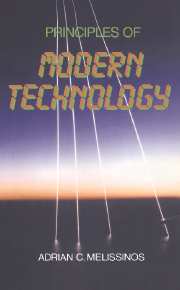1 - The transistor
Published online by Cambridge University Press: 03 December 2009
Summary
Intrinsic semiconductors
It is well known that certain materials conduct electricity with little resistance whereas others are good insulators. There also exist materials whose resistivity is between that of good conductors and insulators, and is strongly dependent on temperature; these materials are called semiconductors. Silicon (Si), germanium (Ge) and compounds such as gallium arsenide (GaAs) are semiconductors, silicon being by far the most widely used material. Solids, in general, are crystalline and their electrical properties are determined by the atomic structure of the overall crystal. This can be understood by analogy to the energy levels of a free atom.
A free atom, for instance the hydrogen atom, exhibits discrete energy levels which can be exactly calculated. A schematic representation of such an energy diagram is shown in Fig. 1.1(a). If two hydrogen atoms are coupled, as in the hydrogen molecule, the number of energy levels doubles as shown in part (b) of the figure. If the number of atoms that are coupled to each other is very large – as is the case for a crystal – the energy levels coalesce into energy bands as in Fig. 1.1(c). The electrons in the crystal can only have energies lying in these bands.
When an atom is not excited the electrons occupy the lowest possible energy levels. In accordance with the Pauli principle only two electrons (one with spin projection up and the other down) can be found at any one particular energy level.
- Type
- Chapter
- Information
- Principles of Modern Technology , pp. 3 - 41Publisher: Cambridge University PressPrint publication year: 1990



